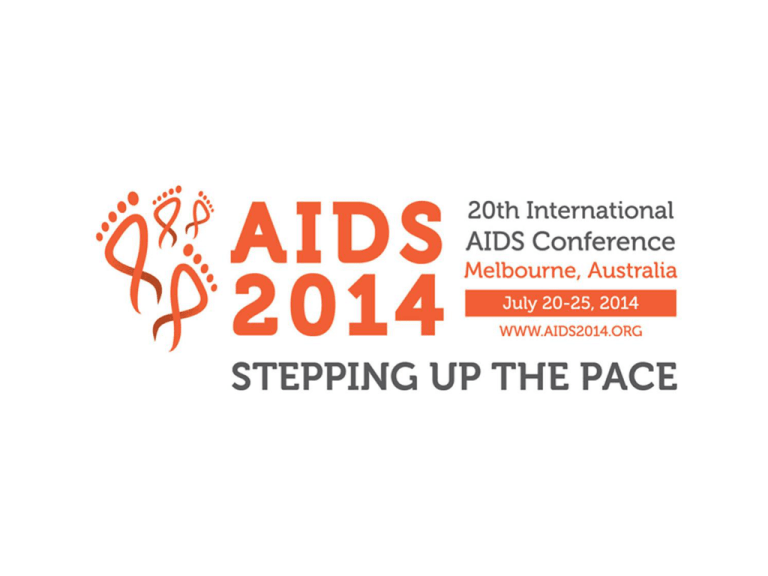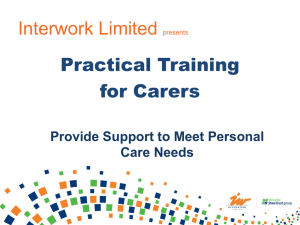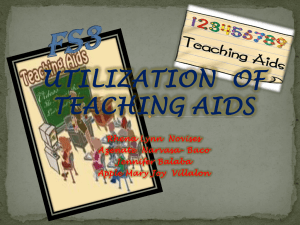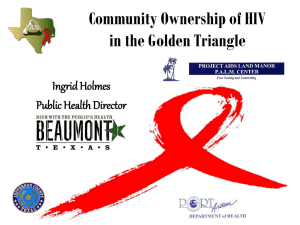
14,000+ participants from around the world
Brings
Bringstogether
togetherScience,
science, Community
community and
and Leadership
leadership
Photos: © IAS/Steve Shapiro – Commercialimage.net
Photos: © IAS/Steve Shapiro, Commercialimage.net
World’s largest, most comprehensive AIDS conference
14,000+ participants from around the world
Photos: ©
© IAS/Marcus
IAS/Steve Shapiro
Commercialimage.net
Photos:
Rose ––Steve
Forrest/Workers’ Photos
As a delegate at AIDS 2014
you can expect to:
• engage with leaders on issues related to the three
conference pillars: Science, Community and
Leadership
• access new science
• take part in policy debates
• be exposed to new ideas and build your network
• develop synergies across disciplines
• increase engagement at a regional and global level.
www.aids2014.org
AIDS 2014 Chairs
AIDS 2014 will be chaired by two eminent scientists, two women who have been
critical to the continued development of science to overcome HIV and AIDS
Françoise Barré-Sinoussi, PhD
AIDS 2014 International Chair
President, International AIDS Society;
Director, Regulation of Retroviral Infections
Institut Pasteur, Paris;
2008 Nobel Prize in Medicine for co-discovery of HIV
Sharon Lewin, FRACP, PhD
AIDS 2014 Local Co-Chair
Professor and Head,
Department of Infectious Diseases, Alfred
Hospital and Monash University;
Co-Head, Centre for Biomedical Research,
Burnet Institute, Melbourne, Australia
www.aids2014.org
AIDS 2014 Partnerships
The International AIDS Conference represents a wide partnership with the International
AIDS Society (IAS) as convener. The partnership includes:
PERMANENT PARTNERS
• Global Network of People Living with HIV (GNP+)
• International Council of AIDS Service Organizations (ICASO)
• International Community of Women with HIV/AIDS (ICW)
• UNAIDS, the Joint United Nations Programme of HIV/AIDS
NON-PERMANENT PARTNERS
• Positive Women’s Network (PWN)
• Sidaction
AUSTRALIA BASED PARTNERS
• The Australian Agency for International Development (AusAID)
• The Australasian Society for HIV Medicine (ASHM)
• The National Association of People Living with HIV in Australia (NAPWHA)
REGIONAL BASED PARTNERS
• The AIDS Society of Asia and the Pacific (ASAP)
• The National AIDS Research Institute of India (NARI)
• The Asia Pacific Network of Sex Workers (APNSW)
www.aids2014.org
AIDS 2014 in Melbourne
• AIDS 2014 will take place at the Melbourne Convention and Exhibition
Centre, Australia’s most versatile convention and exhibition facility
located in the heart of the vibrant and welcoming city of Melbourne.
• Hosting AIDS 2014 in Melbourne will make it possible for those across
the Asia Pacific region to attend the conference.
• AIDS 2014 is organized with support from the City of Melbourne, the
State Government of Victoria, the Federal Government of Australia
and various scientific and community leaders from Australia, as well as
from Asia and the Pacific.
www.aids2014.org
HIV and AIDS in Asia Pacific Region
• Nearly 5 million people are living with HIV across the Asia
Pacific Region.
• The epidemic in this region is diverse, as HIV
epidemiology varies greatly from country to country,
location to location.
• For example, injecting drug use drives the epidemic in
countries like Malaysia, but in others the marginalization
of sex workers and men who have sex with men (MSM)
translates into few from these groups accessing treatment
and prevention services.
• Only 30% of pregnant women in Asia have access to HIV
testing and only 16% have access to treatment to prevent
mother-to-child transmission of HIV.
www.aids2014.org
HIV and AIDS in Australia
•
By the end of 2010, an estimated 30,486 cases of HIV infection had been
diagnosed in Australia and an estimated 25,166 people were living with HIV
infection. This corresponds to an overall prevalence of approximately 0.1 percent.
•
The incidence of HIV infection in Australia is stable at approximately 1,000 cases
per year.
•
Mother-to-child transmission of HIV remains extremely low in Australia.
•
In the period 2006-2010, an estimated 68% of new HIV occurred among men who
have sex with men, 25% were attributed to heterosexual contact, 3% to injecting
drug use and exposure was undetermined in 7% of new HIV diagnoses.
•
Very few AIDS cases or HIV-related deaths are recorded each year in Australia
due to the wide availability of multiple lines of antiretroviral therapy.
•
A partnership approach is central to the development, continuation,
implementation, surveillance and monitoring of HIV strategies in Australia.
Governments, the community sector (representing people living with HIV and their
communities), researchers, clinicians and the health sector workforce are all
partners in Australia’s response to HIV.
Statistics above from UNAIDS Australia Country Progress Report 2012
www.aids2014.org
Key Topics at AIDS 2014
GLOBALLY:
• historic time for science in the global response against HIV and AIDS
• continued need to invest now or pay later
• End of Millennium Development Goals in 2015
• universal access to treatment and care
• stigma and discrimination challenges
• Continuing vaccine and cure research.
ASIA PACIFIC REGION:
• wide diversity in access to care
• success stories in prevention, treatment and care
• unacceptable discriminatory laws in some countries
• programmatic focus on disproportionately burdened populations.
www.aids2014.org
AIDS 2014 Conference Objectives (1/2)
• To engage, inspire, innovate and advocate – in partnership with
affected communities, government, scientists, clinicians and all
stakeholders – working towards the end of AIDS through prevention
measures and comprehensive care and treatment for all.
• To broaden the understanding that the same barriers that have fuelled
the epidemic over the past 30 years still exist today and need to be
broken down including stigma, discrimination and repressive policies,
attitudes and practices. These impede the application of scientifically
proven prevention and treatment options and violate the human rights
of those affected.
• To raise awareness that progress in responding to the AIDS epidemic
is being achieved at different speeds: in many countries – both
developed and developing – the HIV response has made great
advances while in many others, new infections continue to rise due to
funding, structural, policy and political challenges.
www.aids2014.org
AIDS 2014 Conference Objectives (2/2)
•
To put focus on global HIV epidemic hotspots and scale up efforts within
Key Affected Populations (KAPs) including men who have sex with men,
sex workers, people living with HIV, transgender, and people who use
drugs. It is clear that many people are still being ‘left behind’ in HIV
prevention, diagnosis, treatment and care. Solutions require partnerships
with KAPs.
•
To acknowledge the pivotal role the HIV response has played in
transforming global health over the past three decades and to build upon
this momentum by: increasing funding for innovative HIV scientific
research and programmes; involving a new generation of young
scientists, community leaders, politicians and advocates; involving the
cross fertilization of experience and expertise from other disciplines.
• To assist in fostering the current debate around a post 2015
Millennium Development Goals (MDG) scenario for HIV and AIDS,
including the cross cutting issues of criminalization, gender based
violence, sexual health rights and stigma and discrimination. Ensuring
that HIV and AIDS remains a key focus of international development.
www.aids2014.org
Stepping up the Pace - Theme of AIDS 2014
The HIV and AIDS field has seen renewed optimism over the past few years with substantial
gains made in cure and vaccine research, growing numbers of people receiving antiretroviral
treatment, falling rates of infection and more evidence on Treatment as Prevention. However, this
progress has not been universal with many regions struggling to address their HIV epidemic
among a backdrop of ever increasing infections and difficulties in funding, implementation and
political challenges.
Stepping up the Pace recognizes that we are at a critical time and we need to capture the
optimism that has recently emerged and build on it to ensure that HIV remains on top of the
global agenda. The pace needs to further increase to ultimately reverse the trajectory of the
epidemic.
Stepping up the Pace reminds us that we have to energize and revitalize our efforts to increase
investments, collaborative research and political commitment. This can be done through
controlled and coordinated action, including significant programme scale-up in resource-limited
settings, commitment to evidence-based interventions, and more effective and intensive
interventions in “hotspots” where Key Affected Populations (KAPs) are being left behind. Crucially
there is the need to involve KAPs and address the stigma and discrimination which they face,
including punitive government policies.
Stepping up the Pace reflects the crucial opportunity that AIDS 2014 will provide for
mobilizing stakeholders, joining forces and building on the present momentum necessary to
change the course of the epidemic.
www.aids2014.org
Principles of the International AIDS Conference
• Meaningful inclusion of people living with HIV and key
affected populations, and optimize mechanisms for
meaningful participation.
• Be accountable and transparent in planning and
implementing the conference.
• Ensure gender equality in representation at all levels of
the planning and in the implementation of the conference.
• Develop a robust, comprehensive programme to present
the most current science, best medical practice
information, and community experience.
www.aids2014.org
AIDS 2014 Programme
The Conference Programme is made up of three pillars:
1. Scientific
2. Community
3. Leadership and Accountability.
Within the Scientific Programme there are multiple tracks:
Track A: Basic and Translational Research
Track B: Clinical Research
Track C: Epidemiology and Prevention Research
Track D: Social and Political Research, Law, Policy and Human Rights
Track E: Implementation Research, Economics, Systems and Synergies
with other Health and Development Sectors
www.aids2014.org
AIDS 2014 Programme Overview
Programme Sessions
Programme Activities
Opening/Closing
Sessions
Abstract-driven
Sessions
Youth Programme
Plenary Sessions
Bridging Sessions
Global Village
Symposia
Special Sessions
Workshops
www.aids2014.org
Abstract driven sessions
• Offer the highest caliber of state-of-the-art knowledge and peer-reviewed
research.
• Over half of all conference sessions will be abstract driven
Oral
Presentations
Poster
Discussions
Poster
Exhibitions
Late Breaker
Presentations
Track A: Basic and Translational Research
Track B: Clinical Research
Track C: Epidemiology and Prevention Research
Track D: Social and Political Research, Law, Policy and Human Rights
Track E: Implementation Research, Economics, Systems and Synergies with other
Health and Development Sectors
www.aids2014.org
Non-abstract driven sessions
In addition to abstract driven sessions, AIDS 2014 will feature a number
of different sessions including symposia sessions, bridging sessions and
special sessions addressing a variety of current viewpoints and issues.
DAILY PLENARY SESSION
These sessions feature some of the world’s most distinguished HIV
scientists, policy specialists and community leaders.
Key note speakers will include world leaders, community activists and
celebrities.
Plenary sessions will bring together all conference delegates at the first
session of every morning.
www.aids2014.org
AIDS 2014 Global Village
• A diverse and vibrant space where community gathers to
meet, share and learn from each other.
• Open to AIDS 2014 delegates and the general public.
• Admission is free.
• Promotes networking between north and south, east and
west.
• Provides space for displays, discussions , performances
from throughout the world and a marketplace.
• Invites participants to see how science translates into
community action and interventions.
www.aids2014.org
AIDS 2014 Youth Programme
•
•
•
Almost half of all new HIV infection in the world are among people under 25
Globally, 5.4 million young people are living with HIV
Young people remain the most vulnerable group to HIV infection due factors
including lack of information, education, societal influences, and inability to
access healthcare services.
The AIDS 2014 Youth Programme strengthens the participation of young people
and the profile of youth issues through:
•
•
•
•
•
•
Youth website
Youth pavilion
Youth-driven sessions
Electronic youth bulletin
Youth opening and reception
High-level youth leadership forum.
Lower registration fees for all young people under age 26 and youth scholarships
Statistics
above from WHO
www.aids2014.org
Register early for AIDS 2014!
AIDS 2014 registration opens on World AIDS Day – 1st December 2013
Early registration is encouraged to benefit from discounted rate
Conference delegate
Standard fee
Late fee
(after 20 Feb 2014)
Last Minute fee
(after 2 May 2014)
Middle/low income
Countries*
USD 575
USD 690
USD 765
High-income countries*
USD 785
USD 940
USD 1045
Australian & New Zealand
inc. ASHM Membership #
USD 885
USD 1040
USD 1145
Regular Delegate
Youth (under age 26)/Student/Post-doc
Middle/low income
Countries*
USD 150
USD 180
USD 200
High-income countries*
USD 235
USD 280
USD 310
Australian & New Zealand
inc. ASHM Membership #
USD 275
USD 320
USD 350
* For definition of High/Middle/Low income countries, please go to www.aids2014.org
# Australian & New Zealand delegates not wanting ASHM membership should simply use the high-income countries rate
www.aids2014.org
Australian & New Zealand Delegates
•
The Australasian Society for HIV Medicine (ASHM) is the local scientific
partner and supporter of AIDS 2014
•
ASHM will not hold its annual scientific meeting in 2014, instead it is fully
incorporated into AIDS 2014
•
ASHM is a multidisciplinary professional organisation that supports the HIV,
viral hepatitis and sexual health workforce visit www.ashm.org.au for more
information
•
Australians and New Zealanders working in the HIV sector are strongly
encouraged to attend AIDS2014 and to join or renew membership of ASHM
at this discounted rate USD100 for full membership and USD40 a saving of
$87 and $26 respectively, for the 2014-2015 membership year
•
Australian and New Zealand delegates not wanting to join or renew ASHM
membership should simply register using the high income countries rate
www.aids2014.org
Be part of AIDS 2014
Don’t miss the AIDS 2014 Webinar Series!
The webinars will provide updates on AIDS 2014 and will cover a wide
variety of topics aimed at strengthening he participation and
engagement of young individuals, communities, leaders, and scientists
at the conference.
For more information: www.aids2014.org/webinars/aspx
www.aids2014.org
Follow AIDS 2014
Join the conversation and follow AIDS 2014 on
Social Media! Get the latest conference updates
and share your thoughts and ideas through the
AIDS 2014 social media channels.
www.facebook.com/InternationalAIDSConference
@AIDS_conference #AIDS2014
www.youtube.com/user/iasaidsconference
Sign-up for monthly email updates (from November 2013)
www.aids2014.org
Contact us
Check regularly the AIDS 2014 website: www.aids2014.org for news
and updates about the conference
AIDS 2014 Local Secretariat – Melbourne, Australia
Alfred Health
(Old Baker Building – Level 1)
PO BOX 25143
55 Commercial Road Melbourne
Victoria, 3004 Australia
Phone: +61 (0) 3852 79301
AIDS 2014 International Secretariat – Geneva, Switzerland
Phone: +41 (0) 22 710 0800
Email: info@aids2014.org
Media related enquiries should be sent to media@aids2014.org
www.aids2014.org
Sponsors and Supporters (as of Oct 2013)
Destination Sponsors
www.aids2014.org
Sponsors and Supporters (as of Oct 2013)
Major Industry Sponsors
www.aids2014.org
Sponsors and Supporters (as of Oct 2013)
Donors
Official Transport Agent
www.aids2014.org
Sponsors and Supporters (as of Oct 2013)
With Support From
www.aids2014.org







